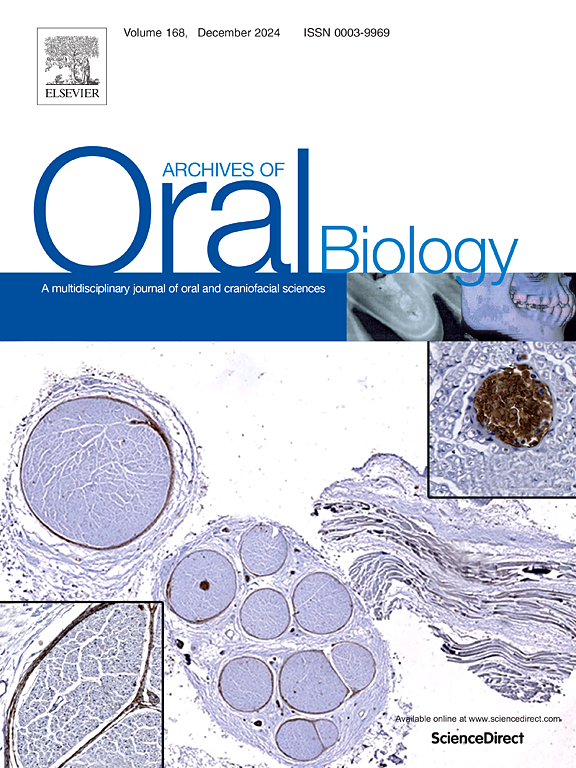吸烟、疾病和牙龈卟啉单胞菌fimA基因型分布之间的关系:来自韩国牙周炎患者的见解
IF 2.1
4区 医学
Q2 DENTISTRY, ORAL SURGERY & MEDICINE
引用次数: 0
摘要
目的:研究韩国成年人群中牙龈卟啉单胞菌fimA基因型分布与吸烟和牙周炎严重程度的关系,并评估基因型特异性与宿主和环境因素的相关性。设计:283名成年人的龈下生物膜样本,包括102名不吸烟的健康人、98名不吸烟的牙周炎患者和83名吸烟的牙周炎患者。提取细菌DNA,采用fimA特异性PCR检测牙龈假单胞菌及其6种fimA基因型(I、II、III、IV、V和Ib)。采用Fisher精确检验和logistic回归模型进行统计分析。结果:II型fimA是所有组中最常见的基因型,在牙周炎患者中更为普遍。Fisher的精确检验显示,除了I型和III型外,健康个体和患病个体之间的基因型分布存在显著差异。Logistic回归显示,牙龈假单胞菌检测与疾病分期密切相关(优势比:7.5),II型fimA与疾病晚期相关。IV型和Ib型与吸烟和年龄显著相关,表明特定基因型对环境暴露的不同反应。结论:考虑到fimA基因型与吸烟之间的明显关联,仔细考虑菌株选择对未来研究牙龈假单胞菌发病机制至关重要。本研究强调了基因型特异性微生物分析在阐明牙周炎进展机制中的重要性,并强调了吸烟等环境因素在菌株水平上塑造微生物变异的潜力。本文章由计算机程序翻译,如有差异,请以英文原文为准。
Associations between smoking, disease, and Porphyromonas gingivalis fimA genotype distribution: Insights from Korean periodontitis patients
Objective:
To investigate the distribution of Porphyromonas gingivalis fimA genotypes in relation to smoking and periodontitis severity in a Korean adult population, and to assess genotype-specific associations with host and environmental factors.
Design:
Subgingival biofilm samples were obtained from 283 adults, comprising 102 non-smoking healthy individuals, 98 non-smoking periodontitis patients, and 83 smoking periodontitis patients. Bacterial DNA was extracted and analyzed using fimA-specific PCR to detect P. gingivalis and its six fimA genotypes (I, II, III, IV, V, and Ib). Statistical analyses were performed using Fisher’s exact test and logistic regression models.
Results:
Type II fimA was the most common genotype across all groups and was significantly more prevalent in periodontitis patients. Fisher’s exact test revealed significant differences in genotype distribution between healthy and diseased individuals, except for types I and III. Logistic regression showed that P. gingivalis detection was strongly associated with disease stage (odds ratio: 7.5), with type II fimA linked to advanced disease. Types IV and Ib were significantly associated with smoking and age, suggesting differential responses of specific genotypes to environmental exposure.
Conclusions:
Given the distinct associations between fimA genotypes and smoking, careful consideration of strain selection is crucial for future studies investigating P. gingivalis pathogenesis. This study underscores the importance of genotype-specific microbial analyses in elucidating mechanisms of periodontitis progression and highlights the potential for environmental factors such as smoking to shape microbial variation at the strain level.
求助全文
通过发布文献求助,成功后即可免费获取论文全文。
去求助
来源期刊

Archives of oral biology
医学-牙科与口腔外科
CiteScore
5.10
自引率
3.30%
发文量
177
审稿时长
26 days
期刊介绍:
Archives of Oral Biology is an international journal which aims to publish papers of the highest scientific quality in the oral and craniofacial sciences. The journal is particularly interested in research which advances knowledge in the mechanisms of craniofacial development and disease, including:
Cell and molecular biology
Molecular genetics
Immunology
Pathogenesis
Cellular microbiology
Embryology
Syndromology
Forensic dentistry
 求助内容:
求助内容: 应助结果提醒方式:
应助结果提醒方式:


